Top 10 Foods Highest in Isoleucine
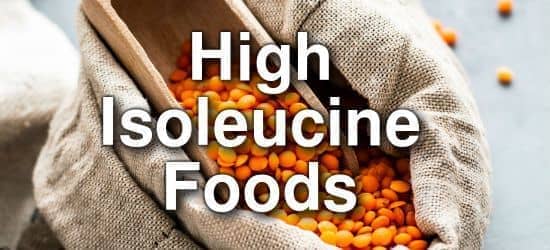
Isoleucine is an essential amino acid necessary for creating hemoglobin as well as regulating blood sugar and energy levels. (1)
Foods high in isoleucine include beef, chicken, pork, fish, tofu, dairy, beans, lentils, whole grains, nuts, seeds, and vegetables like peas.
The reference dietary intake (RDI) for isoleucine is 20mg per kilogram of body weight or 9mg per pound. A person weighing 70kg (~154 pounds) should consume around 1400mg of isoleucine per day. (2)
Below is a list of the top 10 foods highest in isoleucine with the %RDI calculated for someone weighing 70kg (154lbs). For more high isoleucine foods see the extended list of isoleucine rich foods.
Looking for foods low in isoleucine?
Use the nutrient ranking tool to sort through the list of low isoleucine foods.
Also see: Fruits, vegetables, and fats are low in isoleucine.-
 1. Beef (Skirt Steak)
1. Beef (Skirt Steak)
Isoleucine
per 6oz SteakIsoleucine
per 100gIsoleucine
per 200 Calories2686mg
(192% RDI)1580mg
(113% RDI)1179mg
(84% RDI)More Red Meat High in Isoleucine
- 110% RDI per 3oz of veal roast
- 104% RDI per 3oz of lamb roast
- 92% RDI per 3oz beef pot roast
- 82% RDI per 3oz buffalo steak
- 69% RDI per 3oz beef hamburger
See all meats high in isoleucine.
-
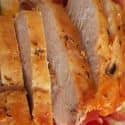 2. Lean Chicken Breast
2. Lean Chicken Breast
Isoleucine
in a 6oz BreastIsoleucine
per 100gIsoleucine
per 200 Calories2674mg
(191% RDI)1573mg
(112% RDI)2004mg
(143% RDI)More Poultry High in Isoleucine
- 212% RDI per chicken leg
- 172% RDI per 6oz turkey breast
- 164% RDI per cup of chicken breast
- 121% RDI per cup of roast duck
- 103% RDI per chicken thigh
See all meats high in isoleucine.
-
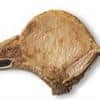 3. Lean Pork Chops
3. Lean Pork Chops
Isoleucine
in a 6oz ChopIsoleucine
per 100gIsoleucine
per 200 Calories2496mg
(178% RDI)1468mg
(105% RDI)1506mg
(108% RDI)More Pork High in Isoleucine
- 117% RDI per cup of roast ham
- 100% RDI per 5oz of ribs
- 84% RDI per 3oz pork tenderloin
- 78% RDI per 3oz pork bratwurst
- 73% RDI per 3oz of ground pork
- 42% RDI per 3oz of bacon (~1oz)
See all meats high in isoleucine.
-
 4. Tuna
4. Tuna
Isoleucine
in a 6oz FilletIsoleucine
per 100gIsoleucine
per 200 Calories2343mg
(167% RDI)1378mg
(98% RDI)1498mg
(107% RDI)More Fish High in Isoleucine
- 165% RDI per 7oz grouper fillet
- 155% RDI per 6oz salmon fillet
- 148% RDI per 6oz tilapia fillet
- 147% RDI per 6.5 oz snapper fillet
- 138% RDI per 6oz pike fillet
See all fish high in isoleucine.
-
 5. Firm Tofu
5. Firm Tofu
Isoleucine
per CupIsoleucine
per 100gIsoleucine
per 200 Calories2139mg
(153% RDI)849mg
(61% RDI)1179mg
(84% RDI)More Soy Products High in Isoleucine
- 104% RDI per cup of tempeh (fermented tofu)
- 99% RDI per cup of boiled soybeans (edamame)
- 59% RDI per 1/2 cup of natto
- 25% RDI per cup of soybean sprouts
- 20% RDI per 8oz cup of soymilk
-
 6. Milk
6. Milk
Isoleucine
per 16oz GlassIsoleucine
per 100gIsoleucine
per 200 Calories853mg
(61% RDI)174mg
(12% RDI)1024mg
(73% RDI)More Dairy High in Isoleucine
- 55% RDI per cup of low-fat yogurt
- 52% RDI per 1/2 cup of low-fat ricotta
- 38% RDI per oz of grated Parmesan
- 33% RDI per cup of plain yogurt
- 31% RDI per oz of Swiss cheese
- 30% RDI per cup of low-fat buttermilk
- 26% RDI per oz of cheddar cheese
See all dairy products high in isoleucine.
-
 7. Lentils
7. Lentils
Isoleucine
per CupIsoleucine
per 100gIsoleucine
per 200 Calories772mg
(55% RDI)390mg
(28% RDI)672mg
(48% RDI)Beans High in Isoleucine
- 55% RDI per cup of large white beans
- 52% RDI per cup of pinto beans
- 52% RDI per cup of kidney beans
- 50% RDI per cup of navy beans
- 48% RDI per cup of black beans
See all beans high in isoleucine.
-
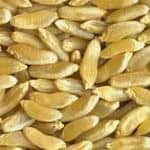 8. Kamut (Khorasan - Wheat)
8. Kamut (Khorasan - Wheat)
Isoleucine
per CupIsoleucine
per 100gIsoleucine
per 200 Calories378mg
(27% RDI)220mg
(16% RDI)333mg
(24% RDI)More Whole Grains High in Isoleucine
- 26% RDI per cup of teff
- 21% RDI per cup of quinoa
- 20% RDI per cup of pasta
- 20% RDI per cup of wild rice
- 19% RDI per cup of oatmeal
- 16% RDI per cup of brown rice
See all whole grains high in isoleucine.
-
9. Squash and Pumpkin Seeds
Isoleucine
per 1oz HandfulIsoleucine
per 100gIsoleucine
per 200 Calories359mg
(26% RDI)1265mg
(90% RDI)441mg
(31% RDI)More Nuts and Seeds High in Isoleucine
- 26% RDI per oz of hemp seeds
- 20% RDI per oz of sunflower seeds
- 19% RDI per oz of pistachios
- 18% RDI per oz of flax seeds
- 17% RDI per oz of peanuts
- 16% RDI per oz of chia seeds
- 15% RDI per oz of almonds
See all nuts and seeds high in isoleucine.
-
 10. Podded Peas
10. Podded Peas
Isoleucine
per Cup CookedIsoleucine
per 100gIsoleucine
per 200 Calories323mg
(23% RDI)202mg
(14% RDI)777mg
(55% RDI)More Vegetables High in Isoleucine
- 20% RDI per cup of spinach
- 19% RDI per cup of Swiss chard
- 18% RDI per cup of mashed sweet potatoes
- 15% RDI per cup of pea sprouts
- 13% RDI per cup of sweet corn
- 11% RDI per cup of Brussels sprouts
See all vegetables high in isoleucine.
Printable One Page Sheet
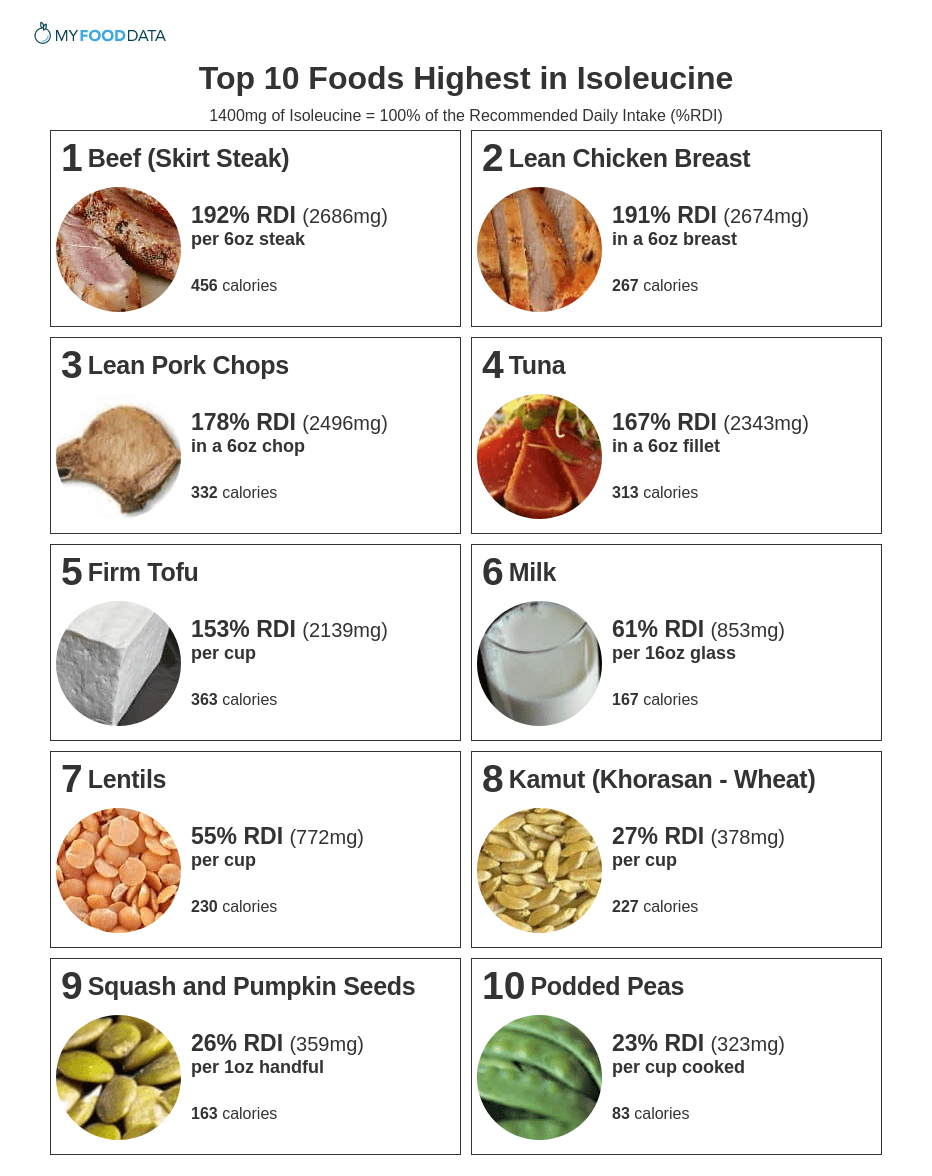
More Foods Rich in Isoleucine
| Food | Serving | Isoleucine |
|---|---|---|
| 1. Baked Beans | per cup | 41% RDI (574mg) |
| 2. Eggs | in 1 large egg | 25% RDI (343mg) |
| 3. Salami | per oz | 22% RDI (304mg) |
| 4. Toasted Wheat Germ | per oz | 22% RDI (303mg) |
| 5. Avocados | per avocado | 12% RDI (169mg) |
| 6. Guavas | per Cup | 11% RDI (153mg) |
| 7. Wheat Bran Bread | per slice | 9% RDI (120mg) |
| 8. Mamey Sapote | 1 cup chopped | 8% RDI (107mg) |
| 9. Kiwifruit | per Cup | 7% RDI (92mg) |
| 10. Apricots | per cup | 5% RDI (64mg) |
About the Data
Data for the curated food lists comes from the USDA Food Data Central Repository.
You can check our data against the USDA by clicking the (Source) link at the bottom of each food listing.
Note: When checking data please be sure the serving sizes are the same. In the rare case you find any difference, please contact us and we will fix it right away.
About Nutrient Targets
Setting targets can provide a guide to healthy eating.
Some of the most popular targets include:- Daily Value (%DV) - The daily value (%DV) is a general guideline for consumption that will prevent deficiency of a particular nutrient in most people. The %DV refers to the percentage of an amount that\'s found in a single serving of a food. It also accounts for absorption factors. It is set by the U.S. FDA.
- Recommended Dietary Allowance (%RDA) - The RDA sets an average daily dietary intake level that is sufficient to meet the nutrient requirements of nearly all (97.5%) healthy individuals. It\'s more specific than the daily value, and varies by age and gender. The RDA is set by the US National Institutes of Health.
- Reference Dietary Intake (%RDI) -The reference dietary intake is similar to the recommended daily allowance, but is specific to age and gender. The RDI for amino acids is set by the U.N. World Health Organization.
- Adequate Intake (%AI) - This value is primarily used in reference to omega-3 and omega-6 fats. The Adequate Intake is set by the U.S. Institute of Medicine. Because there is less evidence to determine the ideal targets for consumption of these nutrients, the specific amount is considered to be less reliable. Using the term Adequate Intake, rather than one of the other terms, helps to emphasize that the ideal intake of that particular nutrient has not yet been scientifically determined.
See the Guide to Recommended Daily Intakes for more information.
Want to set your own targets? Sign up for an account and set custom targets in the daily food log.From the Nutrient Ranking Tool
Use the ranking tool links below to select foods and create your own food list to share or print.
- Foods High in Isoleucine
- Foods Low in Isoleucine
- Vegetables High in Isoleucine
- Fruits High in Isoleucine
- Vegetarian Foods High in Isoleucine
- Nuts High in Isoleucine
- Grains High in Isoleucine
- Beans High in Isoleucine
- Dairy High in Isoleucine
- Breakfast Cereals High in Isoleucine
- Fast Foods High in Isoleucine
View more nutrients with the nutrient ranking tool, or see ratios with the nutrient ratio tool.
Related
Data Sources and References
- PubChem on Isoleucine
- World Health Organization (WHO) Technical Report Series – Protein And Amino Acid Requirements In Human Nutrition ISBN 978 92 4 120935 9
- U.S. Agricultural Research Service Food Data Central
Try the recipe nutrition calculator, or daily meal planner.
Create a free account to log and track foods.

 Next ➞
Next ➞